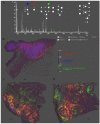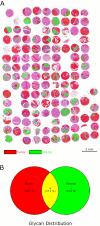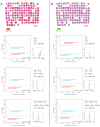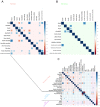Native glycan fragments detected by MALDI-FT-ICR mass spectrometry imaging impact gastric cancer biology and patient outcome
- PMID: 28978092
- PMCID: PMC5620232
- DOI: 10.18632/oncotarget.19137
Native glycan fragments detected by MALDI-FT-ICR mass spectrometry imaging impact gastric cancer biology and patient outcome
Abstract
Glycosylation in cancer is a highly dynamic process that has a significant impact on tumor biology. Further, the attachment of aberrant glycan forms is already considered a hallmark of the disease state. Mass spectrometry has become a prominent approach to analyzing glycoconjugates. Specifically, matrix-assisted laser desorption/ionisation -mass spectrometric imaging (MALDI-MSI) is a powerful technique that combines mass spectrometry with histology and enables the spatially resolved and label-free detection of glycans. The most common approach to the analysis of glycans is the use of mass spectrometry adjunct to PNGase F digestion and other chemical reactions. In the current study, we perform the analysis of formalin-fixed, paraffin-embedded (FFPE) tissues for natively occurring bioactive glycan fragments without prior digestion or chemical reactions using MALDI-FT-ICR-MSI. We examined 106 primary resected gastric cancer patient tissues in a tissue microarray and correlated native-occurring fragments with clinical endpoints, therapeutic targets such as epidermal growth factor receptor (EGFR) and HER2/neu expressions and the proliferation marker MIB1. The detection of a glycosaminoglycan fragment in tumor stroma regions was determined to be an independent prognostic factor for gastric cancer patients. Native glycan fragments were significantly linked to the expression of EGFR, HER2/neu and MIB1. In conclusion, we are the first to report the in situ detection of native-occurring bioactive glycan fragments in FFPE tissues that influence patient outcomes. These findings highlight the significance of glycan fragments in gastric cancer tumor biology and patient outcome.
Keywords: MALDI; formalin-fixed paraffin-embedded tissue; gastric cancer; glycans; mass spectrometry imaging.
Conflict of interest statement
CONFLICTS OF INTEREST The authors declare no conflicts of interest.
Figures






Similar articles
-
Mass Spectrometry Imaging for Glycome in the Brain.Front Neuroanat. 2021 Jul 29;15:711955. doi: 10.3389/fnana.2021.711955. eCollection 2021. Front Neuroanat. 2021. PMID: 34393728 Free PMC article. Review.
-
Native glycan fragments detected by MALDI mass spectrometry imaging are independent prognostic factors in pancreatic ductal adenocarcinoma.EJNMMI Res. 2021 Dec 1;11(1):120. doi: 10.1186/s13550-021-00862-y. EJNMMI Res. 2021. PMID: 34851463 Free PMC article.
-
N-glycan MALDI Imaging Mass Spectrometry on Formalin-Fixed Paraffin-Embedded Tissue Enables the Delineation of Ovarian Cancer Tissues.Mol Cell Proteomics. 2016 Sep;15(9):3003-16. doi: 10.1074/mcp.M116.059816. Epub 2016 Jul 13. Mol Cell Proteomics. 2016. PMID: 27412689 Free PMC article.
-
N-Glycan matrix-assisted laser desorption/ionization mass spectrometry imaging protocol for formalin-fixed paraffin-embedded tissues.Rapid Commun Mass Spectrom. 2017 May 30;31(10):825-841. doi: 10.1002/rcm.7845. Rapid Commun Mass Spectrom. 2017. PMID: 28271569
-
MALDI Mass Spectrometry Imaging of N-Linked Glycans in Cancer Tissues.Adv Cancer Res. 2017;134:85-116. doi: 10.1016/bs.acr.2016.11.009. Epub 2016 Dec 20. Adv Cancer Res. 2017. PMID: 28110657 Free PMC article. Review.
Cited by
-
Mass Spectrometry Imaging for Glycome in the Brain.Front Neuroanat. 2021 Jul 29;15:711955. doi: 10.3389/fnana.2021.711955. eCollection 2021. Front Neuroanat. 2021. PMID: 34393728 Free PMC article. Review.
-
Spatiotemporal diversity and regulation of glycosaminoglycans in cell homeostasis and human disease.Am J Physiol Cell Physiol. 2022 May 1;322(5):C849-C864. doi: 10.1152/ajpcell.00085.2022. Epub 2022 Mar 16. Am J Physiol Cell Physiol. 2022. PMID: 35294848 Free PMC article. Review.
-
The tumour glyco-code as a novel immune checkpoint for immunotherapy.Nat Rev Immunol. 2018 Mar;18(3):204-211. doi: 10.1038/nri.2018.3. Epub 2018 Feb 5. Nat Rev Immunol. 2018. PMID: 29398707 Review.
-
Bringing Matrix-Assisted Laser Desorption/Ionization Mass Spectrometry Imaging to the Clinics.Clin Lab Med. 2021 Jun;41(2):309-324. doi: 10.1016/j.cll.2021.03.009. Clin Lab Med. 2021. PMID: 34020766 Free PMC article. Review.
-
A Novel Mass Spectrometry Platform for Multiplexed N-Glycoprotein Biomarker Discovery from Patient Biofluids by Antibody Panel Based N-Glycan Imaging.Anal Chem. 2019 Jul 2;91(13):8429-8435. doi: 10.1021/acs.analchem.9b01445. Epub 2019 Jun 20. Anal Chem. 2019. PMID: 31177770 Free PMC article.
References
-
- Hakomori S, Kannagi R. Glycosphingolipids as tumor-associated and differentiation markers. J Natl Cancer Inst. 1983;71:231–51. - PubMed
LinkOut - more resources
Full Text Sources
Other Literature Sources
Medical
Research Materials
Miscellaneous

